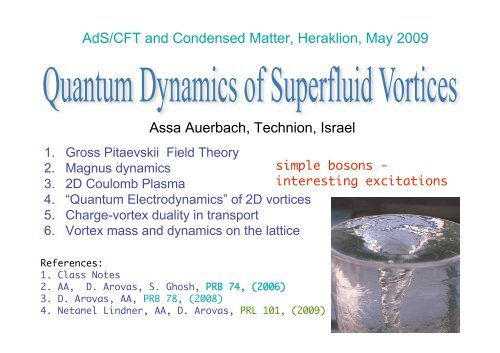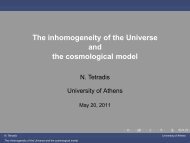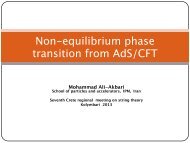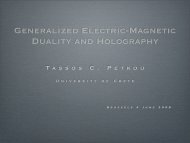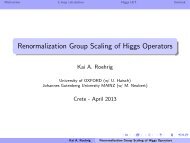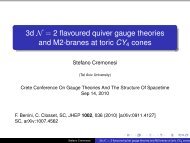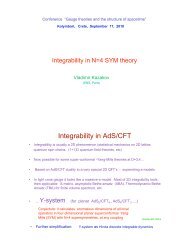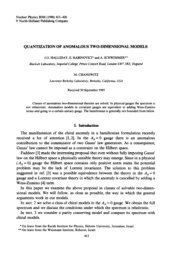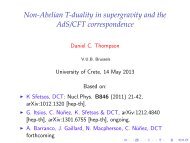Lattice Effects on Interacting Bosons and their Vortex Dynamics
Lattice Effects on Interacting Bosons and their Vortex Dynamics
Lattice Effects on Interacting Bosons and their Vortex Dynamics
Create successful ePaper yourself
Turn your PDF publications into a flip-book with our unique Google optimized e-Paper software.
AdS/CFT <strong>and</strong> C<strong>on</strong>densed Matter, Herakli<strong>on</strong>, May 2009<br />
Assa Auerbach, Techni<strong>on</strong>, Israel<br />
1. Gross Pitaevskii Field Theory<br />
2. Magnus dynamics<br />
simple bos<strong>on</strong>s -<br />
3. 2D Coulomb Plasma<br />
interesting excitati<strong>on</strong>s<br />
4. “Quantum Electrodynamics” of 2D vortices<br />
5. Charge-vortex duality in transport<br />
6. <strong>Vortex</strong> mass <strong>and</strong> dynamics <strong>on</strong> the lattice<br />
References:<br />
1. Class Notes<br />
2. AA, D. Arovas, S. Ghosh, PRB 74, (2006)<br />
3. D. Arovas, AA, PRB 78, (2008)<br />
4. Netanel Lindner, AA, D. Arovas, PRL 101, (2009)
What is superfluidity/superc<strong>on</strong>ductivity<br />
<strong>Interacting</strong> Bos<strong>on</strong>s<br />
Bose field coherent states<br />
Persistent current - rigidity
Gross Pitaevskii theory<br />
Bos<strong>on</strong> Coherent States Path Integral<br />
1<br />
i<br />
Electromagnetic field<br />
Rotating frame:<br />
1. Saddle point energy 2. Semiclassical dynamics
<strong>Vortex</strong> Soluti<strong>on</strong><br />
coherence lengthscale<br />
One flux quantum in the system<br />
<strong>Vortex</strong> (approx.) soluti<strong>on</strong>:<br />
Fluctuati<strong>on</strong>s parameter:<br />
small parameter of Bogoliubov theory<br />
0 1 2 3 4 5
<strong>Vortex</strong> Interacti<strong>on</strong>s: 3D magnetostatics<br />
quantized circulati<strong>on</strong> around each vortex<br />
many vortices<br />
=<br />
static current c<strong>on</strong>servati<strong>on</strong><br />
analogy:<br />
interacting lines of<br />
quantized currents
2D Electrostatics<br />
vortex interacti<strong>on</strong>s = 2D Coloumb<br />
-1<br />
2D One comp<strong>on</strong>ent Coulomb Plasma<br />
1. Incompressible, vortex density = flux density B<br />
2. Ground state = triangular lattice<br />
3. Melting temperature is independent of B
1. Rotating BEC ‘s<br />
Realizati<strong>on</strong>s of superfluid vortices<br />
J. R. Abo-Shaeer et. al., Science 2001<br />
2. Superc<strong>on</strong>ductors in a magnetic field<br />
Nb-Mo<br />
YBCO, Fischer ‘95
Quantum melting in cuprates<br />
Nature Physics 3, 311-314 (2007)<br />
T m<br />
A quantum phase:<br />
<strong>Vortex</strong> c<strong>on</strong>densate<br />
<strong>Vortex</strong> metal<br />
H<br />
T m decreases with field. (N<strong>on</strong> classical)
Magnus Force<br />
F<br />
V
Magnus semiclassical dynamics<br />
X number of bos<strong>on</strong>s enclosed by C<br />
Analogy:<br />
a vortex behaves as a charge in a str<strong>on</strong>g<br />
magnetic field of magnitude<br />
<strong>Vortex</strong> follows equipotential c<strong>on</strong>tours,<br />
i.e. “Goes With The Flow”<br />
Warning: SC dynamics are valid <strong>on</strong>ly for<br />
1. smooth potentials<br />
2. no Umklapp scattering of a lattice
<strong>Vortex</strong> Moti<strong>on</strong><br />
vorticity current<br />
V<br />
a moving vortex creates a stress field
Charge-<strong>Vortex</strong> duality in transport<br />
1. Charge transport equati<strong>on</strong><br />
2. Vortices transport equati<strong>on</strong><br />
Magnus field <strong>on</strong> a vortex<br />
<strong>Vortex</strong> Induced stress field<br />
vortex c<strong>on</strong>ductivity = charge resistivity
Semiclassical transport theory<br />
Semiclassical (smooth potential) dynamics, without tunneling:<br />
a. Vortices follow equipotential c<strong>on</strong>tours:<br />
b. With no potential, vortices ‘Go with the Flow’<br />
<strong>and</strong> the Hall resistance (by Galiliean symmetry) is ‘classical’:<br />
EF<br />
H<br />
V
QED Theory of Phase Fluctuati<strong>on</strong>s<br />
Arovas <strong>and</strong> AA, PRB 78 (2008)<br />
phase modes behave as 2+1D phot<strong>on</strong>s, minimally coupled<br />
to the vortex density <strong>and</strong> current<br />
The phase ‘phot<strong>on</strong>s’ produce<br />
retarded interacti<strong>on</strong>s between vortices,<br />
<strong>and</strong> produce a vortex self energy (mass).
<strong>Vortex</strong> Tunneling in the c<strong>on</strong>tinuum<br />
spatially varying potentials can induce vortex tunneling<br />
1<br />
2<br />
<strong>Vortex</strong> tunneling rate:<br />
Bogoliubov theory yields:<br />
AA, D.P. Arovas, S. Ghosh, Phys Rev B 74, 2006<br />
effective ‘mass’
Summary: vortices in 2D C<strong>on</strong>tinuum<br />
1. Vortices localize <strong>on</strong> equipotential c<strong>on</strong>tours <strong>and</strong> drift with the superflow.<br />
2. GP equati<strong>on</strong> cannot treat short range potential effects.<br />
3. Short range potentials delocalize vortices (make them ‘’quantum’’).
Dick Codor’s impressi<strong>on</strong>...<br />
Quantum <strong>Vortex</strong>
Hard core bos<strong>on</strong>s <strong>on</strong> a square<br />
lattice<br />
Netanel Lindner, AA, D. Arovas, PRL 101, (2009)<br />
1. Vortices have a light mass, vortex solid can melt into a<br />
Quantum <strong>Vortex</strong> Liquid at 0.006 vortices per site.<br />
2. Hall c<strong>on</strong>ductivity (Magnus acti<strong>on</strong>) reverses sign at half filling,<br />
with an associated vanishing temperature scale.<br />
3. Vortices at half filling carry local spin 1/2 doublets. (V-spins)<br />
4. QCP at half filling
Bose Hubbard Model<br />
<str<strong>on</strong>g>Lattice</str<strong>on</strong>g> bos<strong>on</strong>s<br />
Zimanyi et. al. Phys. Rev. B 50 (1994)<br />
Mott insulators<br />
charge order<br />
QCP<br />
superfluid<br />
phase order<br />
S=1/2 , XY model<br />
truncate<br />
S=1, XY Model: relativistic GP<br />
truncate
Hard Core Bos<strong>on</strong>s<br />
Hard core bos<strong>on</strong>s<br />
S=1/2, XXZ model<br />
superfluid<br />
V < t<br />
half filling<br />
charge density wave<br />
V > t
Properties of XXZ model<br />
superfluid density<br />
(classical) Mean field theory<br />
0 1<br />
charge c<strong>on</strong>jugati<strong>on</strong><br />
1. Half filling has maximal stiffness<br />
2. At half filling the Hall c<strong>on</strong>ductivity vanishes<br />
3. Hall c<strong>on</strong>ductivity is antisymmetric about half filling
Magnus force<br />
The strangeness of Half Filling<br />
Magnus dynamics (no dissip.)<br />
hole current<br />
particle current<br />
PH symmetry:<br />
no inertial drift (vanishing Hall c<strong>on</strong>ductivity)
Escher, Day <strong>and</strong> Night, 1938
To study vortex quantum dynamics:<br />
1. Vortices can be introduced into the ground state with<br />
an external magnetic field.<br />
2. <strong>Vortex</strong> effective Hamilt<strong>on</strong>ian can be extracted by<br />
fitting the exact spectrum to an effective hopping model.<br />
3. Hall c<strong>on</strong>ductivity is evaulated using Chern numbers of<br />
the gauged S=1/2 quantum XXZ model a finite torus.
Extracting the vortex hopping rate<br />
<strong>Vortex</strong> Harper hamilt<strong>on</strong>ian<br />
vortex c<strong>on</strong>fining potential<br />
magnus field = bos<strong>on</strong> density<br />
variati<strong>on</strong>al calculati<strong>on</strong><br />
-6.98<br />
Fitting the <strong>Vortex</strong> hopping to exact diag.<br />
-7.11<br />
-7.72<br />
<strong>Vortex</strong> mass = bos<strong>on</strong> mass at half filling
single vortex wavefuncti<strong>on</strong>s<br />
exact diag.<br />
Harper model
Quantum Melting<br />
Multivortex hamilt<strong>on</strong>ian = Bose coloumb liquid<br />
Magro <strong>and</strong> Ceperley: Wigner solid melts at<br />
Therefore, the vortex lattice should quantum melt at<br />
Quantum <strong>Vortex</strong> liquid: not Bose c<strong>on</strong>densed!
torus penetrated by uniform field<br />
lines of zero flux<br />
The Gauged Torus<br />
2 Ahar<strong>on</strong>ov-Bohm fluxes<br />
center of vorticity<br />
Thanks to Gil Refael<br />
<strong>on</strong>e vortex
Thermally averaged Chern numbers<br />
Hall c<strong>on</strong>ductivity<br />
Thouless, Kohmoto, Nightingale, Den-Nijs, PRL (82).<br />
Y. Avr<strong>on</strong>, R. Seiler <strong>and</strong> B. Shapiro, Nucl. Phys. B (86).<br />
“Hall temperature”<br />
high T Kubo<br />
Quantum Critical point
Magnus field reversal<br />
a) b)
<strong>Vortex</strong> degeneracies<br />
Netanel accidentally found the spectrum of a vortex at half filling<br />
to be ‘infested’ with two-fold degeneracies.....<br />
Odd number of vortices<br />
Theorem:<br />
1. Degeneracies corresp<strong>on</strong>d vorticity center <strong>on</strong> all lattice sites.<br />
2. At degeneracies: all the states are even-fold degenerate (doublets).<br />
Proof:<br />
c<strong>on</strong>struct a n<strong>on</strong> commuting algebra of symmetries
The Pi operators<br />
1. reflecti<strong>on</strong> about<br />
2. charge c<strong>on</strong>jugati<strong>on</strong><br />
3. gauge transformati<strong>on</strong><br />
1. point group* symmetries<br />
2. For odd vorticity<br />
=> All states are doubly degerenate<br />
*For <strong>on</strong>e vortex, there are no translati<strong>on</strong>al symmetries <strong>on</strong> finite tori
charge distributi<strong>on</strong>s<br />
Phys Rev A 69 (2004)<br />
v-spin up<br />
staggered charge density<br />
at half filling<br />
Multiple species of vortex c<strong>on</strong>densates were discussed by:<br />
Lannert, Fisher, Senthil, PRB (01)<br />
Tesanovic, PRL 93 (2004),<br />
Balents, Bartosch, Burkov, Sachdev, <strong>and</strong> Sengupta, PRB 71, 144508 (2005).
Illustrati<strong>on</strong> of 3 vortices with v-spin<br />
Implicati<strong>on</strong>s of v-spins:<br />
1. order: CDW (supersolid) in the vortex lattice<br />
2. Low temperature entropy of v-spins
arXiv:0810.2604 :<br />
Summary<br />
Vortices <strong>on</strong> 2D lattices (hard core bos<strong>on</strong>s limit)<br />
1. Have a light mass, vortex solid can melt into a<br />
unc<strong>on</strong>densed Quantum <strong>Vortex</strong> Liquid at 0.006 vortices per site.<br />
2. Hall c<strong>on</strong>ductivity (Magnus acti<strong>on</strong>) reverses sign at half filling,<br />
with an associated vanishing temperature scale.<br />
3. Vortices at half filling carry local spin 1/2 doublets. (V-spins)<br />
4. QCP at half filling<br />
QVL (metal)<br />
B<br />
CDW<br />
(insulator)<br />
<strong>Vortex</strong> solid (superfluid)<br />
1<br />
t/V


